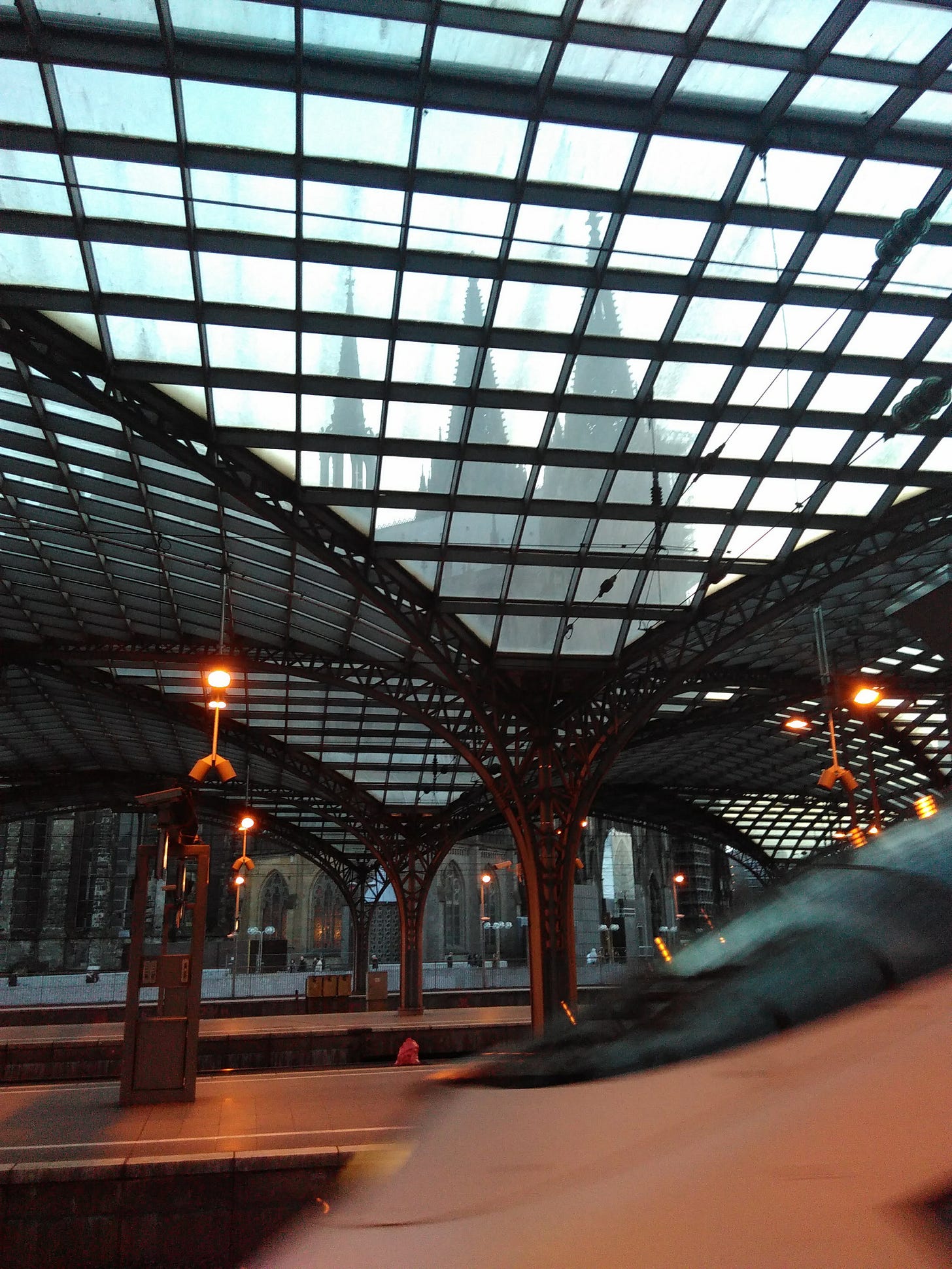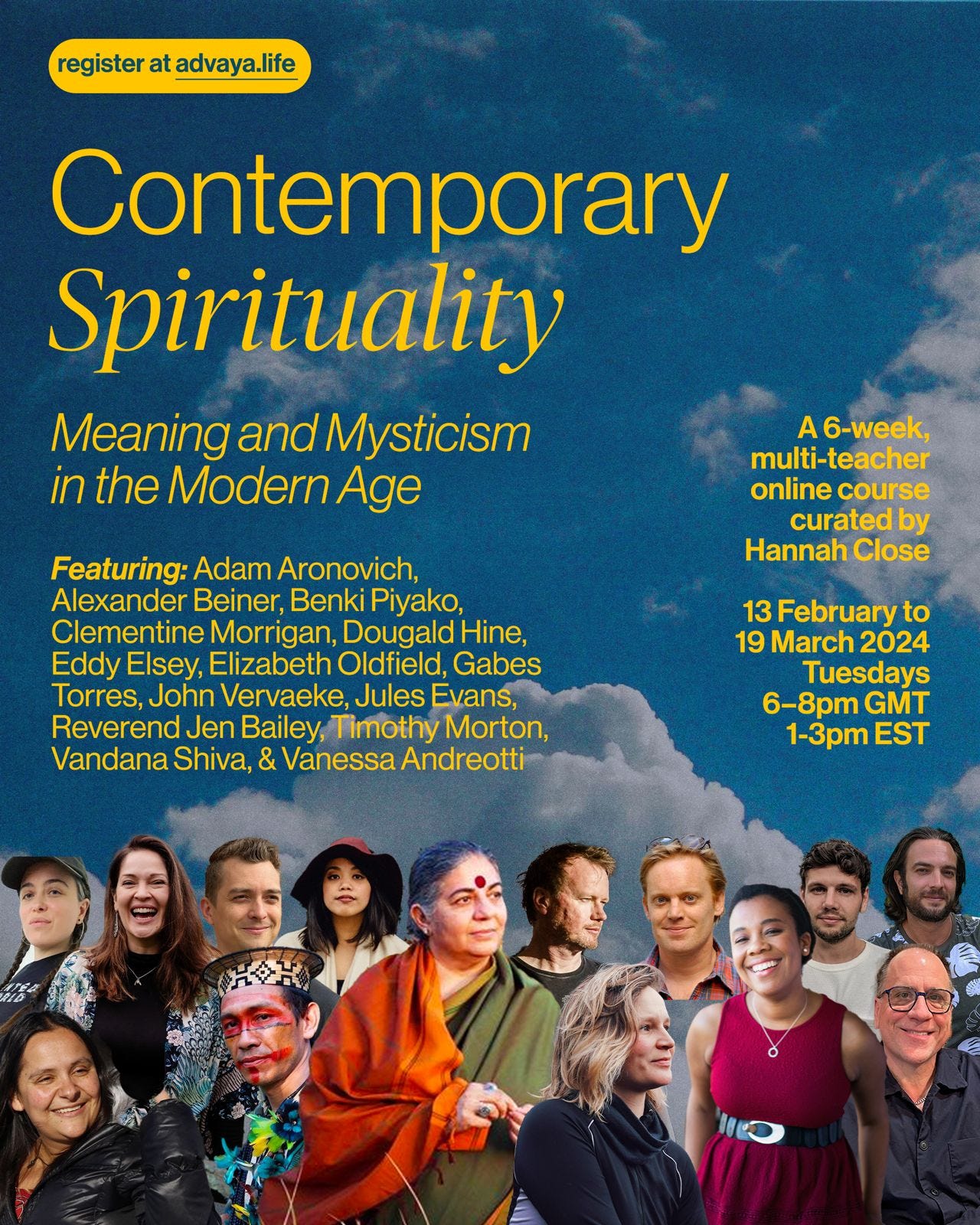This is an invitation to the Contemporary Spirituality: Meaning and Mysticism in the Modern Age course with Advaya, starting on 13 February. You can book at a 15% reduction on the regular fee, using the discount code SPIRIT-HINE.
In the south tower of Cologne Cathedral, there is a bell that weighs 24 tons and measures three yards across. Its sound carries for twenty miles and some of the frequencies are below the range of human hearing.
Ivan Illich describes guiding a visitor around Cologne, a New Zealander on her first visit to Europe. Stepping out of the station, something hits her in the stomach, pulling her off-balance, so that she has to lean against a buttress, and she asks if he is feeling the same thing. It takes some time for him to understand: the bells are ringing, and she has been hit by a sensation entirely foreign to her experience, the deep hum of that largest bell, a sound “too low for the ear but not for the guts.”
There are words that sound like bells, deep enough to hit you in the body. When I read the invitation to teach on the course that
has brought together for Advaya, what struck me was the sheer weight of the words: Contemporary Spirituality: Meaning and Mysticism in the Modern Age. That’s a lot of heavy language to hang together in a title. The other teachers are a heavyweight crew, as well, with some good friends and co-conspirators of mine – Vanessa Andreotti, , Nora Bateson – alongside the likes of John Vervaeke, Timothy Morton and .Use the discount code SPIRIT-HINE for a 15% discount on the regular fee.
My part within all this – the invitation said – would be to talk about “digging where we stand”, and when I read those words, I knew that I was in, because they threw me back to the instruction with which Alastair McIntosh opens his book, Soil and Soul:
The great disease of our times is meaninglessness. If fresh wellsprings of hope are to be found, we must first cut through the collective hallucination that ‘there is no alternative’ to nihilism. We must dig where we stand. We must get beneath the grassroots of popular culture and down to the eternal taproot. Here new life can grow from ancient stock.
There’s a story I heard from a friend who has been working for a long while with a First Nations community. Somewhere along the way, a message came from the elders, based on what they were seeing of the visitors this work was bringing to the reservation. I doubt these were the words they used, but you might say it was a message about trauma and how we deal with it.
“We’re worried about these white folks,” said the elders. “It seems like they need everyone to sit and listen, while each person tells the story of everything that happened to them. And we’re worried that there isn’t time.”
They wanted to send a reminder that there are other ways of dealing with what happened to you, ways that can be more effective than everyone always having to tell their individual story – and that this can be what ceremony is for.
And the way I heard the message, it didn’t sound as though they were saying we should all come to Sun Dance next year. What I heard was an invitation to look back into our own cultures, the places we’re starting from, to look for those traditions and practices whose power we may have forgotten.
Among the stories Alastair tells in Soil and Soul, there’s one that has been on my mind. He’s travelling up the West Coast of Scotland with Stone Eagle, a Mi’Kmaq Warrior Chief, to give theological testimony at a public inquiry – along with a leading theologian of the Free Presbyterian Church – into proposals for a superquarry that would destroy a mountain on the Isle of Harris.
It’s a wild undertaking, to say the least, and on their northbound journey he has planned a series of detours, including a night staying at Iona Abbey. But a storm blows up and their party is unable to cross to the island. While Alastair is disappointed, Stone Eagle’s partner quietly points out to him that “when missionaries have made your childhood a misery, the idea of sleeping in an abbey is not exactly the stuff of sweet dreams.”
The next morning, the weather is changed and the ferry can sail. They come ashore and walk up through the ancient graveyard to enter St Oran’s Chapel.
“I never knew you people had places like this!” Stone Eagle exclaims, tracing a pattern on a grave slab that reminds him of a Mi’Kmaq Star. And then he turns to his hosts. “If you’re into all this,” he demands, “then how come your people destroyed our sacred sites?”
There’s a lot in that story. A weight in the words that won’t let us off the hook, coming from a man for whom the cultural genocide of the mission schools was first-hand experience.
For those of us coming from the corners of the world from which the settlers and missionaries set out, it’s easy to want to disown our ancestors, to curse the structures and forms in which they met the sacred. Until the last few years, in many of the circles that I’ve moved in, people would effuse about experiences with everyone else’s traditions, but you’d rarely hear anyone mention Christianity, except to disparage it.
Lately, things have got more complicated. There’s a belated awareness of cultural appropriation, for one thing. And then there are the high-profile conversions. As much of a stir as these understandably cause, what makes a deeper impression on me are the quieter stories reflected in pieces like
’s The Food Church and ’s Beautiful, Terrible Community.So those are some of the coordinates by which I want to steer in my contribution to what promises to be quite a polyphony of voices. It feels like the setting in which to speak about staying with the trouble of this “homeward turn” that seems to be going on just now.
If there’s something in this invitation that resonates with you, then the Contemporary Spirituality course runs for six weeks, starting on 13 February.
To book at a 15% discount on the regular fee, use the discount code SPIRIT-HINE.





I lived in Cologne for many years and know the power of that bell. I was in the cathedral once when the organ was being tuned. The binaural beats coming from the low frequencies that were nearly the same as the tuning progressed put me into ecstatic trance...it was magnificent. Thank you, Dougald, for this moving story and for sharing news of this course ♥️🙏🏻
And this, Dougald, is why I'm chuffed you're joining the crew. Wonderful words and images as always. 'Words that sound like bells' indeed.